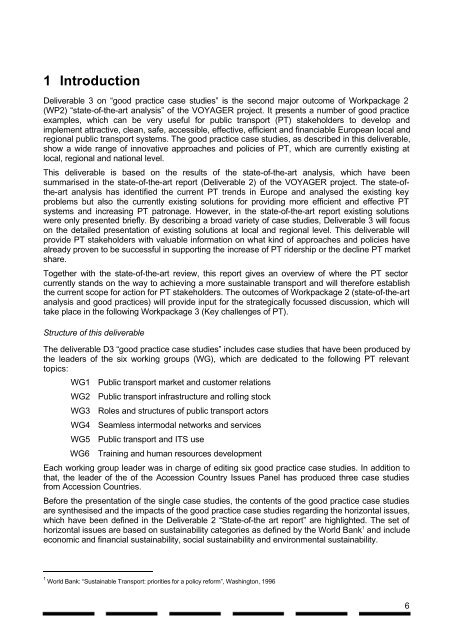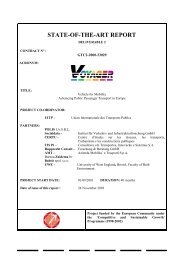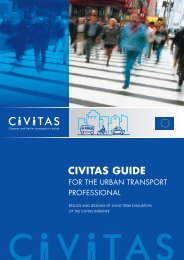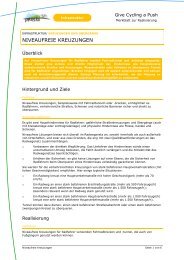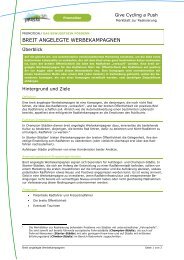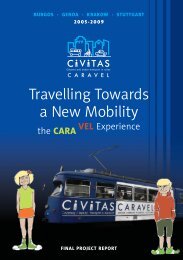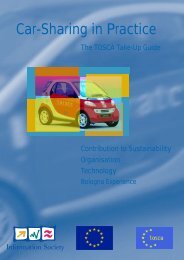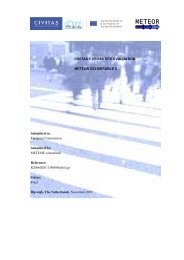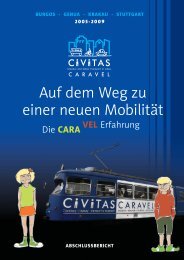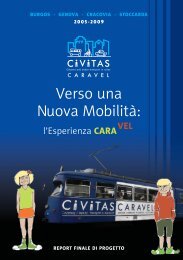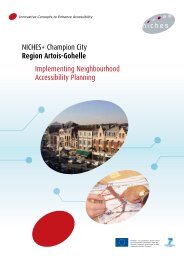VOYAGER Good Practice Case Studies - Rupprecht Consult
VOYAGER Good Practice Case Studies - Rupprecht Consult
VOYAGER Good Practice Case Studies - Rupprecht Consult
You also want an ePaper? Increase the reach of your titles
YUMPU automatically turns print PDFs into web optimized ePapers that Google loves.
1 Introduction<br />
Deliverable 3 on “good practice case studies” is the second major outcome of Workpackage 2<br />
(WP2) “state-of-the-art analysis” of the <strong>VOYAGER</strong> project. It presents a number of good practice<br />
examples, which can be very useful for public transport (PT) stakeholders to develop and<br />
implement attractive, clean, safe, accessible, effective, efficient and financiable European local and<br />
regional public transport systems. The good practice case studies, as described in this deliverable,<br />
show a wide range of innovative approaches and policies of PT, which are currently existing at<br />
local, regional and national level.<br />
This deliverable is based on the results of the state-of-the-art analysis, which have been<br />
summarised in the state-of-the-art report (Deliverable 2) of the <strong>VOYAGER</strong> project. The state-ofthe-art<br />
analysis has identified the current PT trends in Europe and analysed the existing key<br />
problems but also the currently existing solutions for providing more efficient and effective PT<br />
systems and increasing PT patronage. However, in the state-of-the-art report existing solutions<br />
were only presented briefly. By describing a broad variety of case studies, Deliverable 3 will focus<br />
on the detailed presentation of existing solutions at local and regional level. This deliverable will<br />
provide PT stakeholders with valuable information on what kind of approaches and policies have<br />
already proven to be successful in supporting the increase of PT ridership or the decline PT market<br />
share.<br />
Together with the state-of-the-art review, this report gives an overview of where the PT sector<br />
currently stands on the way to achieving a more sustainable transport and will therefore establish<br />
the current scope for action for PT stakeholders. The outcomes of Workpackage 2 (state-of-the-art<br />
analysis and good practices) will provide input for the strategically focussed discussion, which will<br />
take place in the following Workpackage 3 (Key challenges of PT).<br />
Structure of this deliverable<br />
The deliverable D3 “good practice case studies” includes case studies that have been produced by<br />
the leaders of the six working groups (WG), which are dedicated to the following PT relevant<br />
topics:<br />
WG1 Public transport market and customer relations<br />
WG2 Public transport infrastructure and rolling stock<br />
WG3 Roles and structures of public transport actors<br />
WG4 Seamless intermodal networks and services<br />
WG5 Public transport and ITS use<br />
WG6 Training and human resources development<br />
Each working group leader was in charge of editing six good practice case studies. In addition to<br />
that, the leader of the of the Accession Country Issues Panel has produced three case studies<br />
from Accession Countries.<br />
Before the presentation of the single case studies, the contents of the good practice case studies<br />
are synthesised and the impacts of the good practice case studies regarding the horizontal issues,<br />
which have been defined in the Deliverable 2 “State-of-the art report” are highlighted. The set of<br />
horizontal issues are based on sustainability categories as defined by the World Bank 1 and include<br />
economic and financial sustainability, social sustainability and environmental sustainability.<br />
1 World Bank: “Sustainable Transport: priorities for a policy reform”, Washington, 1996<br />
6


